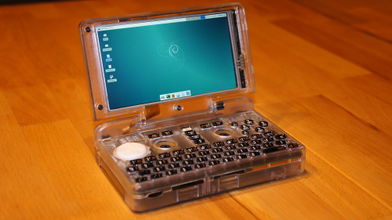Frequently Asked Questions
Overview
To get a general idea of what's in the Pyra, check out the Dragonbox Pyra page.

What's the current development status?
Have prototype, will open pre-orders soon (possibly 1 May).
Who's ED?
You've probably seen this on the forums. It's the digrammaton for our benevolent dictator EvilDragon.
What to expect when booting Pyra for the first time
First Run Wizard
After booting, the screen will look something like this. Further refinements to be developed by various members of the community. The first run wizard will walk you through creating a user, setting a password, and the usual keyboard setup.
Help, I'm a Linux n00b!
How do I connect to WiFi?
What software is available for the Pyra?
How do I install software?
The default Pyra OS is based on Debian, which allows for simple installs/upgrades.
For CPU/GPU-intensive programs such as games, however, the standard Debian packages won't be optimized well for the Pyra hardware. Like the Pandora community repository, there will be a Pyra repository which utilizes the DBP (DragonBox Package) format. Check out the DBP install instructions.
How can I control volume via software?
What's this about screen tearing issues?
When will the GPU be fully utilizable?
When will the phone software be ready?
When someone gets around to porting this stuff. It may be a couple months (or longer) after the first preorder Pyras arrive in people's pockets.
How can I customize my Pyra?
How can I change the theme?
How can I tweak the options for Pyra-specific hardware? (e.g. Keyboard, Nubs, Touchscreen, etc.)
Hardware questions
What carrier compatibility is there with the Pyra cell module?
The Pyra has a GSM module, so just say no to CDMA carriers. Check Carrier Compatibility for help/discussion for the country you reside in. But please note, compatible carriers would still likely have to approve the use of the Pyra on their networks.
How can I get the Pyra working on one of the compatible networks?
You may have to call or talk to someone about it, give them the device information, etc.
Can I turn off data and use the Pyra as a dumb phone?
For the above carriers, probably, if/when they allow the device on the network, and if/when the software will be ready.
Why is there not a camera?
At the time of development, all available camera modules are too thick (front to back) to fit inside the lid without enlarging the (already quite thick) case. Putting a camera in the base would result in an awkward and unusable camera angle.
Concerns were also raised about:
- The utility of a small, low-performance camera
- Privacy implications
- Cost
TODO: Link to inevitable thread of adding a USB camera...
Should I get 2GB or 4GB of RAM?
Is bigger always better? Simple GNU/Linux distributions (such as the default Pyra OS) do not require the 1 to 2 GB of memory that other proprietary OSes require, so most of the 2 GB will be available to the user, and this will be sufficient for the vast majority of Pyra software and use-cases. For a demonstration trying to push a Pyra devboard to its limits, check out this video, which doesn't break 2GB of RAM usage. For most users, 2GB RAM will be more advantageous: both economically, and in battery life.
If you want to do things like run your OS in RAM (a la Puppy Linux), run heavy audio/video processing workloads, or play other memory-intensive games (e.g. Minecraft-type games), 4GB might be right for you.
Why not include hardware X on the Pyra?
The reason(s) may include but not be limited to:
- Limited funding
- Limited resources
- Need small minimum order quantities (MOQ) for a niche coummunity's production run, with linux drivers and decent design support
- Potential future upgrades/versions to add it
- Current expected specs are adequate for MOST of the existing community
- Feature creep would mean the Pyra would never get released
- EvilDragon made his decision to not include it
The Pyra will be a modular, hackable device. Just as the Pandora has been lovingly modded, there will be creative solutions to get the most out of the Pyra. The hardware designs for the Pyra are also expected to be open-sourced, so anything is possible in terms of homebrew hardware development.
What's this about eSATA?
See: Storage